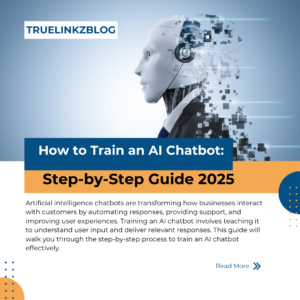How to Train an AI Chatbot: Step-by-Step Guide
Artificial intelligence chatbots are transforming how businesses interact with customers by automating responses, providing support, and improving user experiences. Training an AI chatbot involves teaching it to understand user input and deliver relevant responses. This guide will walk you through the step-by-step process to train an AI chatbot effectively.
Step 1: Define Your Chatbot’s Purpose
Before training your chatbot, define its role and purpose. Consider these questions:
- What is the chatbot’s primary function? (e.g., customer support, sales assistance, etc.)
- Who is your target audience?
- What type of queries or interactions will the chatbot handle?
Clear objectives help structure the training process and set the right expectations.
Step 2: Choose the Right Platform and Technology
Select an AI chatbot framework or platform that aligns with your needs. Popular options include:
- Dialogflow: Google’s NLP platform for building conversational interfaces.
- Rasa: Open-source platform for building AI-powered chatbots.
- Microsoft Bot Framework: Comprehensive tools for creating intelligent bots.
- IBM Watson Assistant: AI-powered chatbot platform by IBM.
Choose a platform based on its features, customization options, and ease of integration with your systems.
How to Use Chatbot AI to Enhance Sales on Your Website 2025
Step 3: Collect and Prepare Training Data
The quality of training data directly impacts the chatbot’s performance. Gather data that represents the types of conversations your chatbot will encounter. This can include:
- Historical chat logs
- Frequently Asked Questions (FAQs)
- Customer emails and feedback
Organize the data into categories such as intents (user goals), entities (specific details), and expected responses. Clean the data to remove duplicates, irrelevant entries, or sensitive information.
Step 4: Define Intents and Entities
- Intents: These are the purposes or goals behind user queries. For example, in a food delivery chatbot, intents could include “Order Food,” “Track Order,” or “Cancel Order.”
- Entities: These represent specific details in user inputs. For instance, in the query “Order a pizza,” “pizza” is the entity.
Define all relevant intents and entities for your chatbot’s domain to ensure accurate responses.
Step 5: Train the Natural Language Processing (NLP) Model
Most chatbot platforms use machine learning to understand and process user input. Train the NLP model by:
- Feeding labeled data for each intent and entity.
- Testing the model with diverse inputs to measure its accuracy.
- Iterating based on test results to improve understanding and response.
Ensure the training dataset includes varied examples of how users might phrase their queries.
Step 6: Design Conversation Flows
A well-structured conversation flow ensures seamless interaction. Create scripts for:
- Greeting messages
- Responses for each intent
- Handling unexpected queries (fallback messages)
Design conditional logic to guide users through complex interactions, such as filling forms or troubleshooting.
Step 7: Test the Chatbot Thoroughly
Before deploying your chatbot, conduct extensive testing to ensure it performs as expected. Types of testing include:
- Functionality Testing: Ensures the chatbot handles all defined intents and entities.
- User Experience Testing: Evaluates the chatbot’s flow and responses from the user’s perspective.
- Stress Testing: Tests the chatbot’s performance under heavy user traffic.
Gather feedback from testers to identify and fix gaps.
Step 8: Deploy and Monitor Performance
After testing, deploy the chatbot to your preferred platforms, such as websites, messaging apps, or mobile apps. Continuously monitor its performance by:
- Analyzing logs and user interactions.
- Tracking metrics like resolution rate, response time, and user satisfaction.
- Identifying patterns in unanswered queries for further training.
Step 9: Regularly Update and Retrain the Chatbot
As user behavior evolves, your chatbot’s training must be updated. Regularly add new data, refine existing models, and enhance responses to improve accuracy and relevance.
Conclusion
Training an AI chatbot is an ongoing process that requires clear objectives, quality data, and iterative improvement. By following this step-by-step guide, you can create a chatbot that effectively meets user needs and enhances customer experience. With the right tools and strategy, your chatbot can become an indispensable asset for your business.

[…] Step 2: Use AI to Generate Story Ideas and Content […]